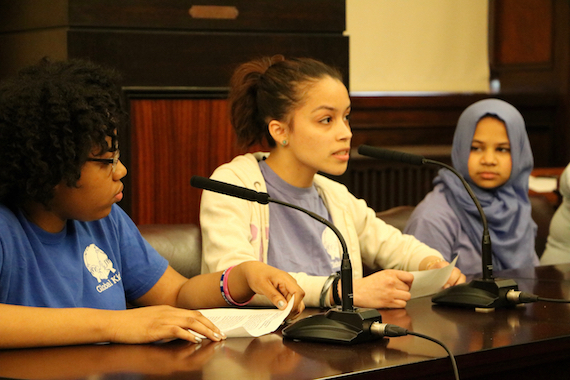
Global Kids Leader Digna Rosales testifying before the New York City Council's Education Committee in support of climate education Resolution 0375 on April 19, 2016.
The first Earth Day events took place across the United States on April 22, 1970. In New York City, Mayor Lindsay shut down Fifth Avenue for a march and participants congregated and rallied at Union Square Park. It was a major national event in response to the negative effects from industrialization on our environment. Waterways, like the Hudson River and Lake Erie, were severely polluted from the toxic waste dumping from factories along shorelines. Links between ubiquitous pesticides and cancer threatened public health. Oil spills were rampant.
I was too young to remember the first Earth Day. But as my education progressed in suburban public schools, I began to make connections between economics, the environment, and politics as world events unfolded. I was fortunate to have several excellent teachers who consistently brought current events into our classroom curriculum and discussions, beginning in elementary school and continuing through high school. The oil and energy crises of the 1970's made me conscious of the environmental and economic impact of fossil fuels as well as global interdependence. Acid rain directly threatened our water supply, fish and wildlife, and air quality and the pollution that caused it knew few boundaries. The toxic "Love Canal" in Niagara Falls highlighted the lack of regulation and accountability for corporate polluters, and the devastating impact that had on the poisoned residents in the vicinity. The list went on.
There was so much to talk about and rather than shy away from what could be deemed as being too complicated for children to understand, several of my teachers throughout the years embraced the opportunity to integrate complex and controversial problems facing our world into their classroom. Today, as the world's scientists and leaders overwhelmingly recognize the threat of climate change and its devastating consequences, the time has come for our educational system to enter the 21st Century and teach comprehensive climate education.
That's why students from Global Kids (GK) have been campaigning for the past two years for comprehensive climate education to be included in New York schools' curriculum. They live in underserved communities in New York City, some that were devastated by Superstorm Sandy. Additionally, many GK students' families come from frontline nations, like Bangladesh and Honduras, which are experiencing the effects of climate change now. While they appreciate and value the benefits of learning "reduce, reuse, recycle," they know it's not enough. Climate education allows for a comprehensive approach to understand the causes and impacts of climate change. It integrates math, science, literacy, social studies, and current events and affords limitless opportunities to develop problem-solving, critical thinking, technology, and civic engagement skills with young people. It can broaden their understanding of career paths as they learn how engineers are working to address rising sea levels; how non-governmental organizations, diplomats, and world leaders negotiate policy to mitigate the effects of climate change; how scientists and conservationists are addressing threats to biodiversity; and how economists calculate and predict the micro and macro economic impact of climate change on our local and global economy; and more.
Climate education also gives voice to those who will disproportionately feel its harmful impact as frontline communities are often poorer people, or people of color. The public needs to know how climate change will do more harm than simply make the weather warmer. They need to know that places like the Marshall Islands and Maldives will disappear and that rising sea levels will cause the displacement of millions of people in Bangladesh as well as the United States East Coast. Severe droughts will cause massive famine. Species will be wiped out, affecting the livelihood of people as well as the balance of nature. Countries will be fighting over dwindling resources. The political, economic, and humanitarian impact of climate change is real.
Unfortunately, students in the United States are not learning about climate change in classrooms. According to a recent survey in the journal Science, teachers were spending an average of one to two hours per school year on the topic of climate change.
In August 2014, Global Kids students partnered with NYC Council Members Costa Constantinides and Donovan Richards to introduce Resolution 0375, which calls upon the New York State Department of Education to include comprehensive climate education in the K-12 public school curriculum. Since then, GK students have been tirelessly campaigning for the resolution through emails, phone calls, social media, and meetings with city officials.
On April 19, 2016, 12 Global Kids high school students testified before the New York City Council's Education Committee. After listening to the students' powerful testimonies, the Committee unanimously voted to pass Resolution 0375. The next day, April 20th, the resolution went before the full New York City Council for a vote, and it was adopted.
While this resolution is non-binding, it is nonetheless powerful. The students will now take their campaign and this resolution to New York State officials that oversee curriculum, and will continue to push for educational policy and curriculum that is responsive to the world we live in and prepares them for the future. They refuse to be passive or accept the status quo. They are learning not only about climate change, but also how government works and how to have influence.
Reduce, Reuse, Recycle. Absolutely. But it is not enough. As we celebrate Earth Day in 2016 by calling for climate education in schools, let us also teach students Engage, Empower, Enact.
⎯Evie Hantzopoulos, Executive Director of Global Kids